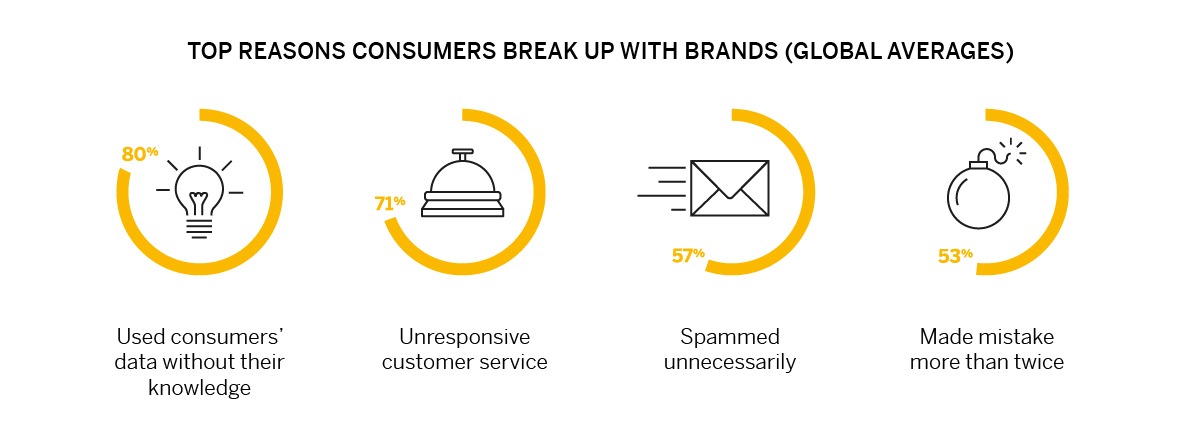In a previous post we discussed the uncanny relationship similarities of love between two people, and love between businesses and customers in the digital age.
We called it a modern courtship with the same principles, and noted that while falling in love might be easy, staying in love was the challenge.
It’s not you, it’s …well, yeah, it IS you
But what happens when customers fall out of love with a brand? What happens when The Break-Up occurs and, more importantly, why?
The customer-brand relationship is a modern dilemma for businesses. When couples split up, there are recurring themes for the primary reason that they end their relationships. Infidelity certainly comes to mind. Indifference, of course. Being smothered gratuitously. Not learning from previous issues.
The similarities to the brand-consumer dynamic is eerily similar, as the 2017 SAP Hybris Global Consumer Insights Report found.

As with personal relationships ending, customer relationships end for nearly the same reasons:
Used consumers’ data without their knowledge = Trust issues, infidelity.
Unresponsive customer service = Neglect, indifference.
Spammed unnecessarily = Smothered gratuitously.
Made mistake more than twice = A failure to learn and grow from previous issues.
Image matters
It’s not just obvious problems that brands face, either. Businesses can’t afford to treat any customer peculiarities and preferences with indifference. For example, a survey by the British-based e-cigarette company Vapour.com found some interesting consumer attitudes when it comes to littering, a big problem in the United Kingdom.
Vapour.com spoke to 1,203 consumers to ask them their opinions on branded litter, what they most commonly see on the streets, and their feelings about these brands.
According to the survey, 76% of participants looked upon a business negatively when seeing their brand amongst waste on the streets; more than a third would be less likely to buy from a brand they see as litter. That included some of the biggest names in global business – 89% of survey participants listed McDonalds as the brand they most associate with litter, and the list also included Coca-Cola, KFC, Cadbury, Starbucks and more.
The upshot? Companies like Coca-Cola European Partners earlier this year agreed to join a government “expert group” to explore ways to better recover plastic drink containers and reduce litter in Great Britain.
Show you care
Being proactive in response to a break-up, and using even more of the modern digital tools available, will help save the relationship, as the Global Consumer Insights Report learned.
“Artificial intelligence, machine learning and big data are offering an evolving service for businesses. Employing cloud-based systems that can store and analyze will be the differentiator for brands in the marketplace. Performance is based on providing prompt and personalized experiences that reward consumers, and a delivery model that equates to one that services rather than just sells products.”
And one other salient point. Like any break-up that leaves one single and free to date, other businesses – competitors – are ready to pounce on a brand’s misfortune.

